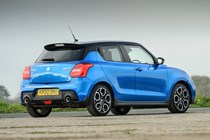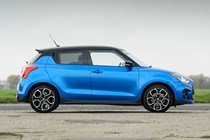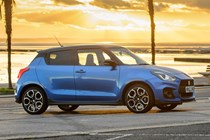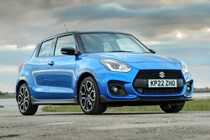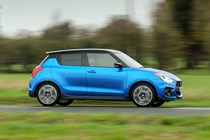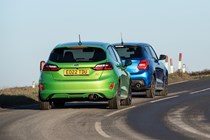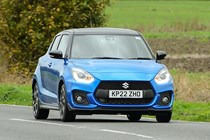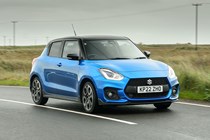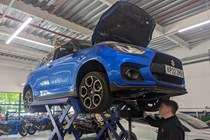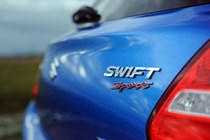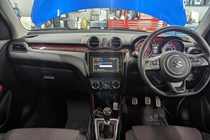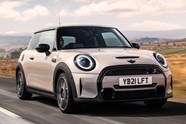
Suzuki Swift Sport review
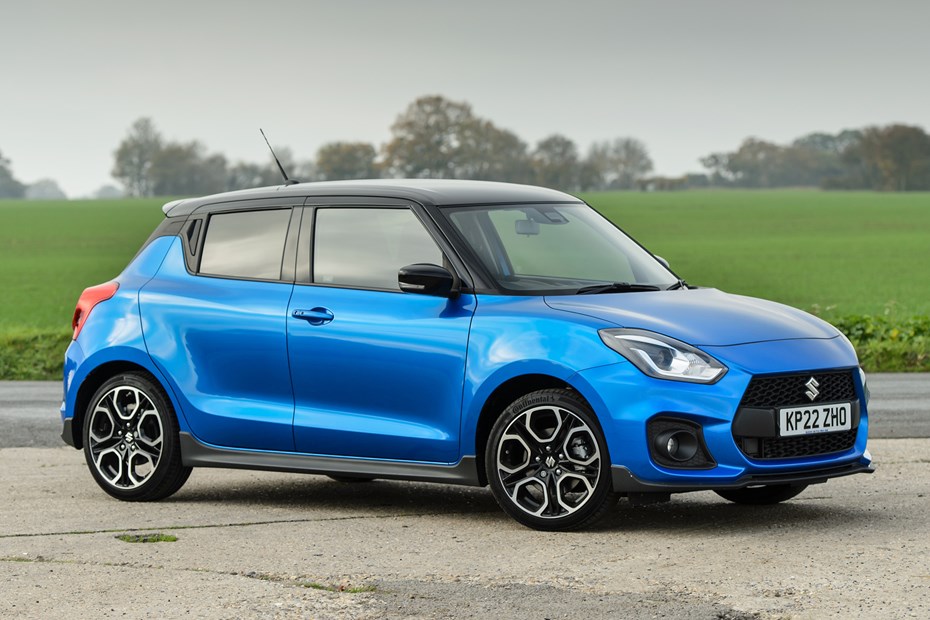
At a glance
| Price new | £19,079 - £24,060 |
|---|---|
| Used prices | £7,778 - £19,775 |
| Road tax cost | £190 |
| Insurance group | 28 - 35 |
Get an insurance quote with

|
|
| Fuel economy | 47 - 50.4 mpg |
| Range | 407 miles |
| Miles per pound | 6.9 - 7.4 |
| View full specs for a specific version | |
Available fuel types
Petrol
Pros & cons
- Lightweight
- Affordable
- Fuel efficient
- Small boot
- Annoying safety kit
- Tiny fuel tank
Suzuki Swift Sport rivals
Overview
The Suzuki Swift Sport targets the same market as the Ford Fiesta ST, Hyundai i20 N and MINI Cooper S. It isn’t as powerful as its main rivals, but it compensates by being lighter than all of its rivals, allowing it to make the most of the power it has. Because of lightness and efficiency, we’ve included it in our list of the best small hot hatchbacks on sale today.
Suzuki updated the Swift Sport in 2020, adding some extra standard equipment. More importantly, it gained mild-hybrid assistance for its 1.4-litre four-cylinder petrol engine. This change left the maximum power down to 129hp from 140hp, but boosted the car’s official fuel economy figure from around 47mpg to 50.4mpg while lowering CO2 emissions from 135g/km to 125g/km.
The Swift Sport is more affordable than its rivals, too. It’s significantly cheaper than the lowest priced Hyundai i20 N, Volkswagen Polo GTI and the entry-level Ford Fiesta ST. And because it’s so efficient, it should also save you money at the pumps.
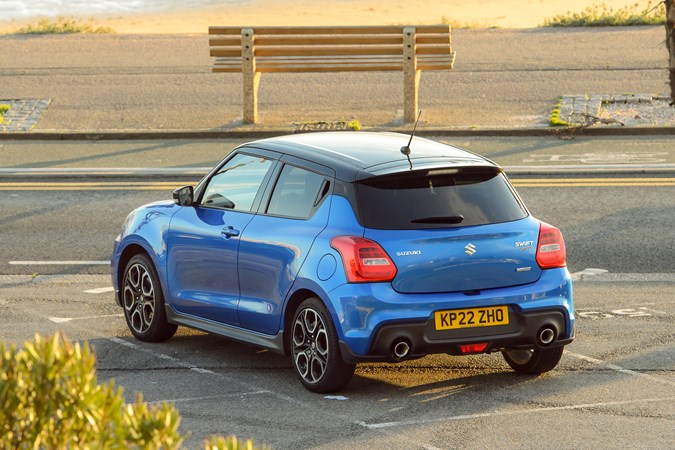
What’s the Suzuki Swift Sport like inside?
Rather basic where modern cars are concerned. The seats are manually adjusted, you get single-zone climate control and the infotainment system only handles media and navigation functions rather than serving as the control hub for every electrical component in the car. It’s spartan, but it’s a setup that works well. The Swift Sport is a masterful lesson in minimalism.
We’ll start with the dashboard layout. It’s incredibly simple. You get a temperature dial, a fan speed dial, some buttons that move the air around the cabin and a touchscreen. That’s your lot. The steering wheel also doesn’t have an overwhelming number of buttons on it and you get traditional analogue dials rather than a customisable digital gauge cluster. This simplicity keeps the price low and makes the Swift Sport easy to get to grips with.
Quality isn’t as good as a Fiesta ST, but that’s partly because of the Swift Sport’s lightweight design brief. Posh soft-touch materials weigh more than scratchy hard plastics, so Suzuki has used them sparingly to cut fat off the car. That’s not to say it’s an unpleasant place to be, though. Even though the materials are on the cheaper side, the interior has been screwed together properly and commonly used controls like the climate dials and stalks feel reassuringly solid.
The seats are comfortable, too. They’re well-shaped with plenty of side bolstering and good lumbar support, despite the fact there’s no lumbar adjustment. We’d have liked them to be mounted a little closer to the floor, though. If you’re tall, it feels like you’re sat on the car rather than in it.
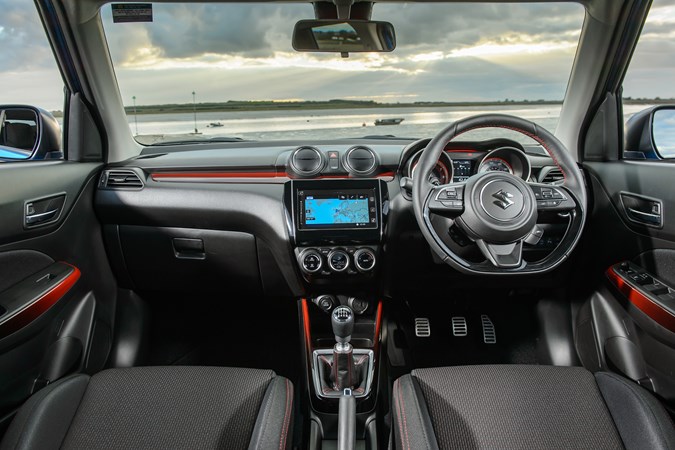
Practicality
The Swift Sport stumbles slightly here. Its boot measures a mere 265 litres, which is 87 litres less than you get in the Hyundai i20 N, 46 litres less than a Fiesta ST and 13 litres less than a five-door MINI Cooper S. By the time you’ve heaved a large suitcase into the boot, there’s little room for anything else.
The rear seats aren’t the most spacious. Headroom is at a premium and, if you’re sitting behind a tall driver, you won’t have much room for your knees. The rear doors don’t open very wide, either. The aperture is rather narrow and, because the roofline slopes down towards the rear of the car, you need to be careful not to bash your head on the roof on your way into the cabin.
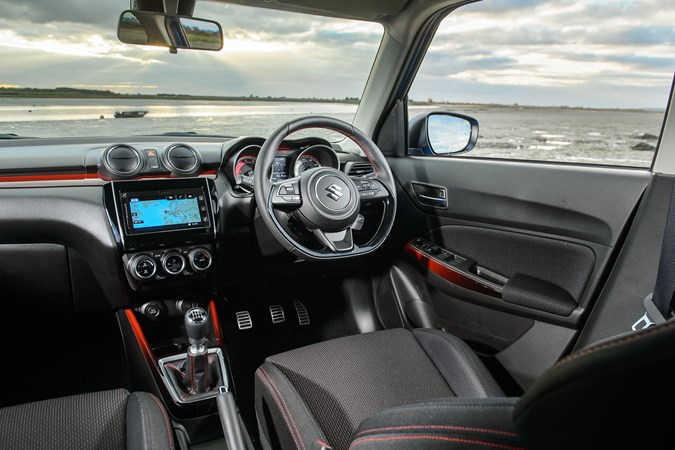
Suzuki’s use of affordable materials works in the Swift Sport’s favour. The dashboard and door cards are wipe-clean, which means you can muck the interior out with a damp dishcloth and some washing up liquid. The seats are also trimmed in conventional cloth rather than the swanky Alcantara you get in the Fiesta ST, which makes them easier to maintain.
Just be wary of the Swift Sport’s dinky fuel tank if you’re planning a big road trip. You’ll only get around 300 miles from a full tank, which means you’ll need to plan your fuel stops before setting off to avoid expensive motorway service station prices. However, if you’re light on the throttle, you can easily manage upwards of 45mpg on the motorway.
Safety
The most basic Suzuki Swift scored just three stars when Euro NCAP first crash tested it back in 2017, although that score rises to four stars for the Swift Sport for the extra safety equipment it receives as standard. That’s good, but it trails the glowing five-star rating awarded to the Fiesta ST.
And while the Swift Sport’s added safety equipment helps to bump up its safety rating, it’s also a cause for irritation. Much like our long-term Suzuki S-Cross, the Swift Sport’s front collision warning system is far too sensitive. It often recognises parked cars and approaching grass verges as hazards – and the dashboard will buzz like an alarm clock until you’ve passed the offending vehicle or rounded the unfavourable corner.
The seat belt warning buzzer is annoying, too. Because the boot is so small, you might need to throw your shopping bags on the rear bench – but the weight sensors in the seats can recognise some objects as humans and scorn them for not fastening their seatbelts. The dashboard will issue the same shrill beep until you stop and lash your belongings into place with the seat belts.
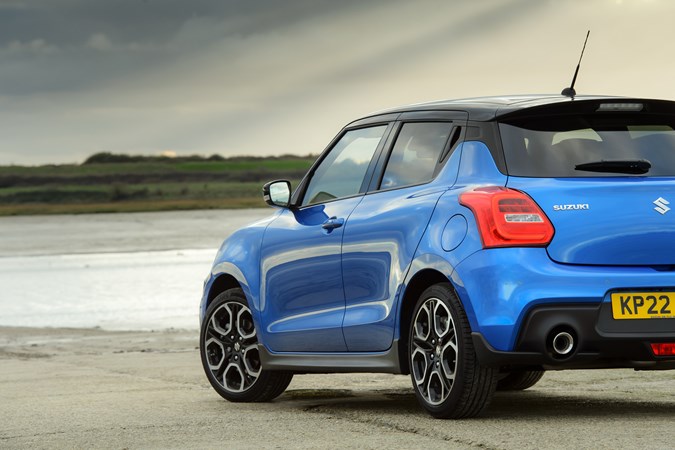
What’s it like to drive?
Here’s where Suzuki turns things around. The Swift Sport is great fun to drive. It won’t set your pulse racing in the same way as a Ford Fiesta ST, partly because it has 70hp less. However, because it’s so down on power, you can use more of the performance more of the time and not worry about losing your licence.
The engine produces 129hp and 235Nm of torque, which Suzuki says is enough for a top speed of 130mph and a 0–62mph time of 9.1 seconds. We believe the first figure, but we reckon Suzuki’s engineers are telling porkies about the latter because the car feels much faster than that. If you can nail your gear shifts, we reckon you could easily shave a second off that time.
And you’ll get plenty of practice at changing gear because you’ll be constantly rowing through the six-speed gearbox to keep the engine in its sweet spot. The unit behaves more like a turbocharged engine from the 1990s – if you let the engine revs drop below 2,500rpm, there’s an entertaining pause in the power delivery before the turbo wakes up again and shunts the car forwards.
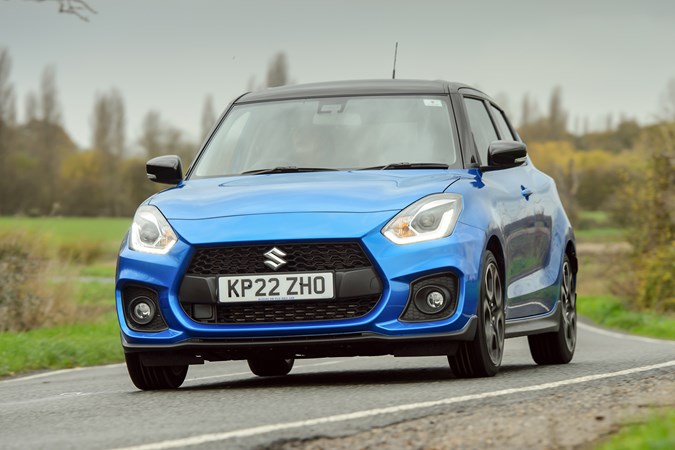
The suspension is softer than the Fiesta ST and Hyundai i20 N’s. Because the Swift Sport is lighter than its rivals, Suzuki didn’t need to fit cast iron springs to control the body. That means it breathes a little easier on yumpy back roads and is more comfortable to live with day-to-day, even if you do sacrifice a bit of cornering sharpness for the privilege.
Even though you don’t get a fancy mechanical limited-slip differential (like you’ll find on an Abarth 695 Competizione or a Fiesta ST) the Suzuki Swift Sport clings on admirably in the corners. There’s plenty of grip available and, because you’re only playing with 129hp, you’re never travelling fast enough to get things irrecoverably out of shape. Unlike its rivals, the Swift Sport isn’t a hooligan – it works with you.
Unlike the interior safety equipment, the Swift Sport’s traction control and stability control systems aren’t irritating in the slightest. They leave plenty of room to let you have fun. The traction control system is so laid back that it’ll let you spin the front wheels away from a set of lights if you leave with gusto. The stability control doesn’t snatch at the brakes through the corners, either.
We’re not stuck on the Swift Sport’s steering, though. There’s a good amount of feedback, but it’s a little loose around the centre and is overly assisted for a hot hatchback. There are also no customisable drive modes that allow you to tailor the weight of the steering. You get used to it after a while, but we can’t help but think the car would have been better to drive with weaker steering assistance. The Fiesta ST, i20 N and Cooper S all do a better job on this front.
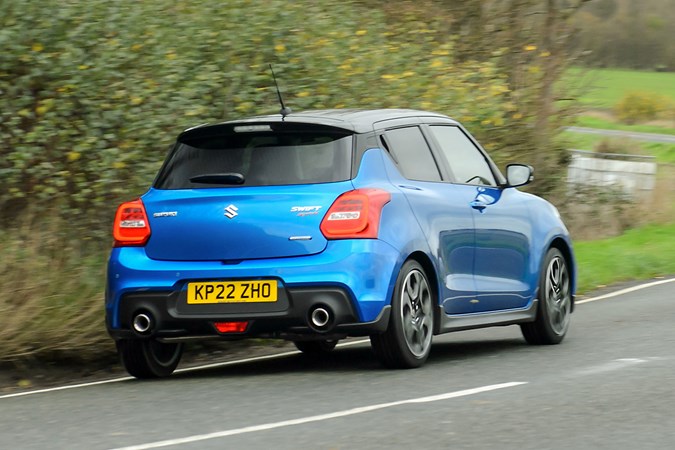
Anything else I should know?
Standard equipment includes 17-inch alloy wheels, LED headlights, front foglights, a 7.0-inch infotainment system, a six-speaker stereo and a rear parking camera. You also get a whole host of driver assistance technology as detailed above, which can get quite irritating. Thankfully, the driving experience makes up for the electrical systems’ incessant beeping.
We need to talk about Suzuki’s warranty scheme, because the brand updated its offer in early 2023. As before, every new Swift Sport is delivered with a standard three-year/60,000-mile manufacturer warranty. However, each time you take your car to a registered Suzuki dealership for its annual service, Suzuki will throw in an additional year’s worth of warranty cover up to a maximum of seven years or 100,000 miles. This change thrusts Suzuki into joint second place in the UK’s new car warranty race, just behind Toyota with its 10-year package.
Most importantly, the Swift Sport is covered under warranty for a longer period of time than the Ford Fiesta ST (three years), Abarth 595 (three years) and the Hyundai i20 N (five years) warranty package. Granted, the Abarth and Hyundai warranties operate on an unlimited mileage basis, but the average buyer will struggle to cover enough miles during the warranty period in either car to take advantage of the scheme. Suzuki’s warranty is more generous.
Read on for our verdict – does the Swift’s blend of lightness, fun and economy make a winner?




